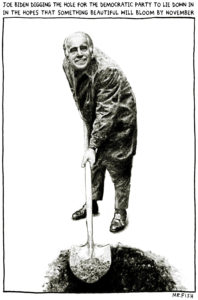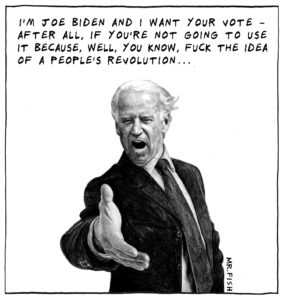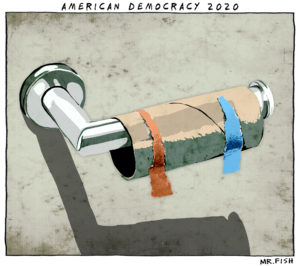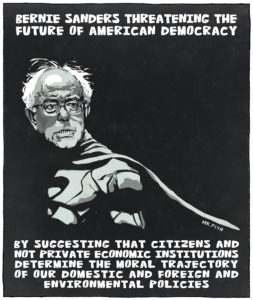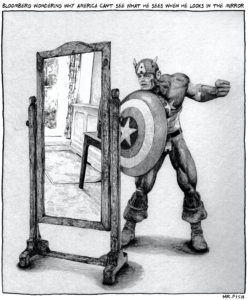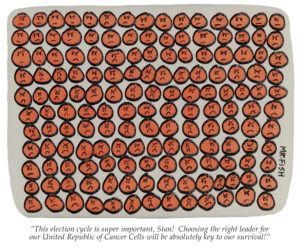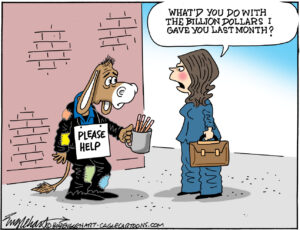Drawing Conclusions: The Editorial Cartoon
Oct 20, 2012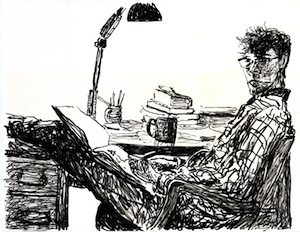
Mr. Fish is the curator of “Drawing Conclusions,” an exhibit exploring the history of editorial cartooning on display at USC Annenberg’s Second Floor Gallery and Room 207 from Oct. 24 to May 13, 2013. It is co-sponsored by The Future of Journalism Foundation, a project of Community Partners.I have no idea what readership is of written editorials, but it doesn’t come anywhere close to the readership of editorial cartoons.
–Paul Conrad, editorial cartoonist for the Los Angeles Times
Stop them damned pictures! I don’t care so much what the papers say about me. My constituents don’t know how to read, but they can’t help seeing them damned pictures! –William “Boss” Tweed, discredited New York politician responding to editorial cartoons by Thomas Nast
Art is a finger up the bourgeoisie ass. –Pablo Picasso
For reasons that may have to do only with the perfunctory indifference that comes with incuriosity, there has never been a precise understanding by the dominant culture of what an editorial cartoonist is. Having been inexorably linked to journalism because their work has traditionally been published in daily newspapers, the value and professional integrity of editorial cartoonists have been unfairly forced to rise and fall with the health of the Fourth Estate.
Thus, with the steady disintegration of the print media and the pandemic elimination of staff cartoonist positions from periodicals everywhere, the question has become: Without an industry to sustain the definition of what an editorial cartoonist has come to mean to the public mind, what will happen to those men and women who draw pictures containing a political or social message? When circumstances in a society shift dramatically enough to make extinct a profession so narrowly defined by myopic and mainstream ideas, does this mean the end of the activity previously exercised within that profession, or does it merely demand a reconfiguration of consciousness allowing for the emergence of a more enlightened understanding of what the editorial cartoonist’s job is and where it might best find support, institutional or otherwise? In other words, is cartooning a vocation or a calling?
It’s arguable that editorial cartooning, in one form or another, has been with us ever since, in the words of Mark Twain, God made the mistake of preserving sin by not forbidding Eve to devour the snake, an act of bureaucratic mismanagement so fundamentally destructive that our sense of moral self-determinism has never been the same. Nor has our belief in the absolute wisdom of our authority figures.
But editorial cartooning has been around even longer than that. In fact, it is not beyond comprehension that we have never been without it, particularly if we are to define the word “editorial” as the exposition of a personal opinion and “cartooning” merely as the rendering of that opinion in pictorial form. Given such a description, we come to find that the earliest practitioners of the art form were editorializing on the walls of limestone caves in the south of France some 33,000 years ago, eons before the Bible places the events that took place in the Garden of Eden. Of even greater significance is how these cave drawings predate the invention of the written word by the Sumerians of ancient Mesopotamia by 30,000 years, proof that when it comes to the mode of communication upon which human beings have historically most relied, it is the visual depiction of our life’s experiences, rather than phonetic symbols arranged on a straight line, that have proven themselves most deeply meaningful.
Other examples through history of editorial cartooning must include the ancient Chinese wall scrolls from the Han Dynasty (206 BCE – 220 CE), which were, put simply, captioned drawings commenting on life, politics and philosophy, a format that every contemporary cartoonist considers absolutely essential. Then there are the Japanese Shunga prints from the Heian period (794 – 1185), which depict sexual scandals of the imperial courts and monasteries, not to condemn those portrayed, but to celebrate both eroticism and how deliciously lascivious the private experience of sex can appear when entertained by those whose public persona is typically considered beyond the lure and lurch of such naked passion – an aesthetic that we see repeated most notably by the Underground Comix movement of the 1960s and ’70s by such artists as Robert Crumb and Gilbert Shelton. There is also the Egyptian storyboarding carved into the tombs and monuments of pharaohs, members of the nobility and government officials, each carving little more than serialized comic strips designed to comment on one’s interaction with the celestial power structure and ethereal elite. There is street graffiti from Pompeii that complains about life’s daily grind and Grecian urns that explore the relationship between man and mythology. There are prayer books from the Middle Ages that extol the questionable virtues of succumbing to the most brutally simplistic notions of good and evil and there are “cartoons” (the origin of the term meaning preparatory drawing for a painting or piece of sculpture) from Leonardo da Vinci and Honore´ Daumier and Auguste Rodin that rejoice in human expression, delight in the poetics of anatomy and refine the art of caricature, our first emoticons.
Then there are the cartoonists from the modern age who, with pen and ink, pencil and paper, Illustrator and Photoshop, produce their work for magazines and newspapers and websites, their subject matter having mostly to do with the cultural, political and religious incongruities that we modern people find most inconsistent with what we consider to be good citizenship, fair and honest self-criticism and an uncompromising intolerance for social and civic injustice. These are cartoonists who, in the interest of advancing the ideas that they have about how best to enable communal preservation and individual freedom, will either vilify those in power, ridicule those apologists for oligarchic or theocratic or corporatocratic tribalism or will target those who, through apathy or active resistance or democratic idealism, threaten the benign and saintly work of a given power structure that they believe was devised by enlightened functionaries to save the world, advance truth and beauty and, in most circumstances, the right to turn a profit for God and country.
And, like their predecessors, these cartoonists will make diligent use of the age-old vocabulary of visual imagery and continue creating works of commentary art regardless of whether the society or the age in which they live supports, encourages or appreciates them.
And, as it’s always been, snakes everywhere will be eaten alive, bred in captivity, obliterated in nature and spared by cock-eyed optimists, and the cartoonist will be there to document the whole magnificent charade.
The exhibit for which this text was written features original work from 16 of the nation’s most celebrated editorial cartoonists working today, plus works from artists who most influence their creative process. Additionally, 54 cartoons and illustrations were chosen for their ability to arouse curiosity about the purpose of both the contemplative and jeering sides of uncensored free expression, to educate those unaware of the art form’s ancient and storied history and, finally, to inspire belief in the future of the cartoonist’s job to test and deepen the integrity of our democracy.
More from Mr. Fish
